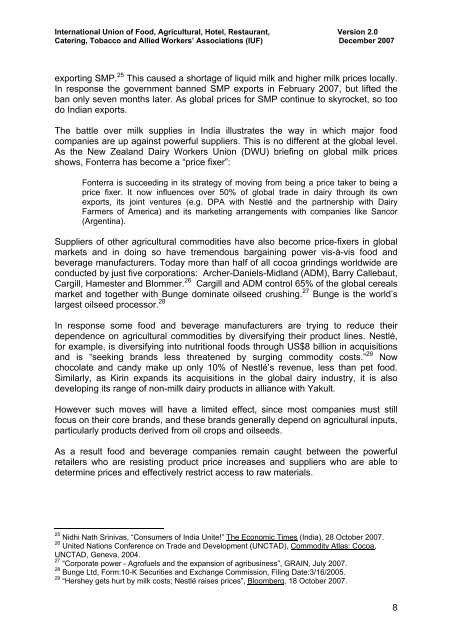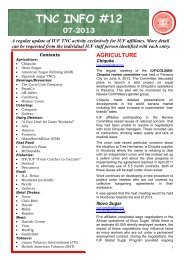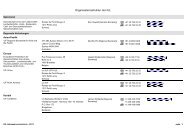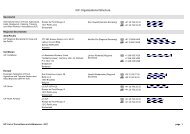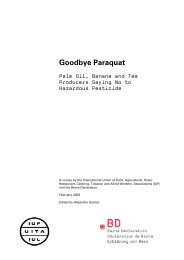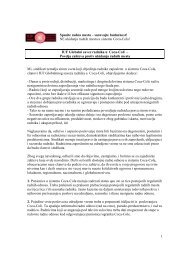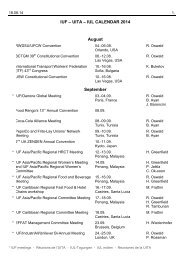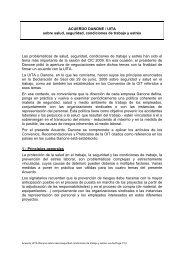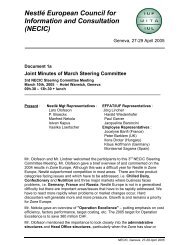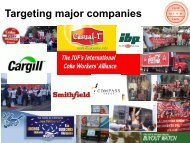Rising Commodity Prices & Food Production:
Rising Commodity Prices & Food Production:
Rising Commodity Prices & Food Production:
Create successful ePaper yourself
Turn your PDF publications into a flip-book with our unique Google optimized e-Paper software.
International Union of <strong>Food</strong>, Agricultural, Hotel, Restaurant, Version 2.0<br />
Catering, Tobacco and Allied Workers’ Associations (IUF) December 2007<br />
exporting SMP. 25 This caused a shortage of liquid milk and higher milk prices locally.<br />
In response the government banned SMP exports in February 2007, but lifted the<br />
ban only seven months later. As global prices for SMP continue to skyrocket, so too<br />
do Indian exports.<br />
The battle over milk supplies in India illustrates the way in which major food<br />
companies are up against powerful suppliers. This is no different at the global level.<br />
As the New Zealand Dairy Workers Union (DWU) briefing on global milk prices<br />
shows, Fonterra has become a “price fixer”:<br />
Fonterra is succeeding in its strategy of moving from being a price taker to being a<br />
price fixer. It now influences over 50% of global trade in dairy through its own<br />
exports, its joint ventures (e.g. DPA with Nestlé and the partnership with Dairy<br />
Farmers of America) and its marketing arrangements with companies like Sancor<br />
(Argentina).<br />
Suppliers of other agricultural commodities have also become price-fixers in global<br />
markets and in doing so have tremendous bargaining power vis-à-vis food and<br />
beverage manufacturers. Today more than half of all cocoa grindings worldwide are<br />
conducted by just five corporations: Archer-Daniels-Midland (ADM), Barry Callebaut,<br />
Cargill, Hamester and Blommer. 26 Cargill and ADM control 65% of the global cereals<br />
market and together with Bunge dominate oilseed crushing. 27 Bunge is the world’s<br />
largest oilseed processor. 28<br />
In response some food and beverage manufacturers are trying to reduce their<br />
dependence on agricultural commodities by diversifying their product lines. Nestlé,<br />
for example, is diversifying into nutritional foods through US$8 billion in acquisitions<br />
and is “seeking brands less threatened by surging commodity costs.” 29 Now<br />
chocolate and candy make up only 10% of Nestlé’s revenue, less than pet food.<br />
Similarly, as Kirin expands its acquisitions in the global dairy industry, it is also<br />
developing its range of non-milk dairy products in alliance with Yakult.<br />
However such moves will have a limited effect, since most companies must still<br />
focus on their core brands, and these brands generally depend on agricultural inputs,<br />
particularly products derived from oil crops and oilseeds.<br />
As a result food and beverage companies remain caught between the powerful<br />
retailers who are resisting product price increases and suppliers who are able to<br />
determine prices and effectively restrict access to raw materials.<br />
25 Nidhi Nath Srinivas, “Consumers of India Unite!” The Economic Times (India), 28 October 2007.<br />
26 United Nations Conference on Trade and Development (UNCTAD), <strong>Commodity</strong> Atlas: Cocoa,<br />
UNCTAD, Geneva, 2004.<br />
27 “Corporate power - Agrofuels and the expansion of agribusiness”, GRAIN, July 2007.<br />
28 Bunge Ltd, Form:10-K Securities and Exchange Commission, Filing Date:3/16/2005.<br />
29 “Hershey gets hurt by milk costs; Nestlé raises prices”, Bloomberg, 18 October 2007.<br />
8


